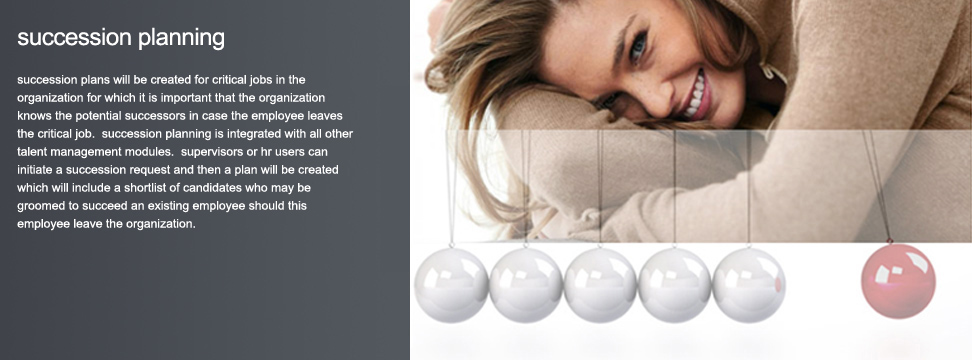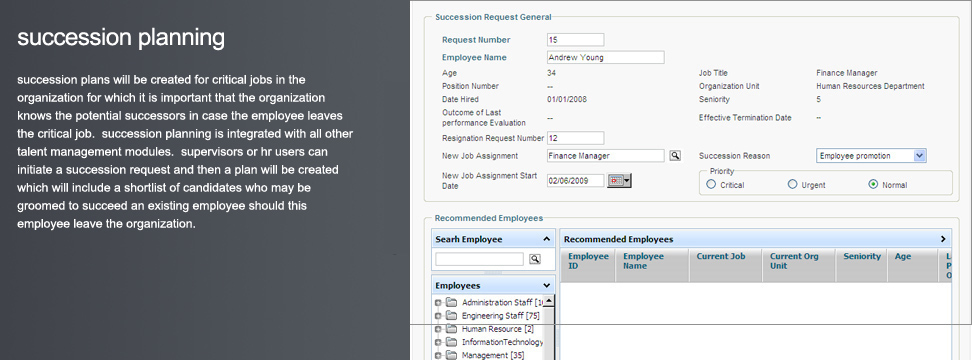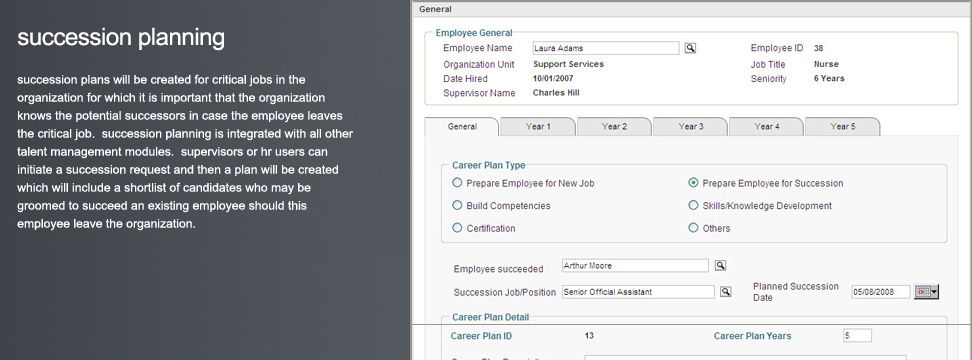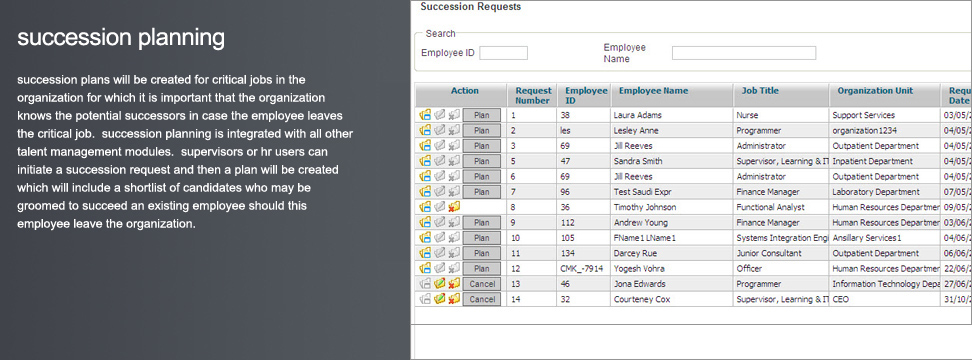 Succession Planning |
Interact HRMS Succession Planning Module Overview
The Succession Planning module in Interact HRMS is a strategic tool designed to identify and prepare internal employees and external applicants for Critical Roles within the organization. By marking jobs or positions that may require succession due to retirement, promotion, or other staffing changes, this module enables organizations to build a talent pipeline and ensure continuity in key roles. Through Career Plans, Competency Evaluations, Performance Appraisals, and Training, the module supports a structured approach to developing potential successors, ensuring they are ready for upcoming opportunities.
This module is ideal for organizations that prioritize leadership continuity, talent development, and proactive workforce planning. With a workflow-based approach that begins with a Succession Request and extends through detailed career planning and training, the Succession Planning module offers a comprehensive solution for managing and preparing successors for critical roles. This structured approach supports business stability, minimizes operational disruption, and ensures a prepared workforce for future growth.
Identification of Critical Jobs and Positions for Succession
The Succession Planning module allows organizations to designate Critical Jobs or Positions that require succession planning, tracking roles that may be affected by retirements, promotions, or other transitions. This process ensures that key roles are marked for succession planning, helping HR focus on building a pipeline for positions that are essential to business continuity.
For example, if a department head plans to retire within the next year, HR can mark this position as critical for succession planning. This designation triggers a process to identify and prepare potential successors, ensuring a smooth transition when the position becomes vacant.
Succession Requests to Initiate Planning Process
The module includes a Succession Request feature, which allows managers, employees, or HR users to initiate succession planning for a specific position. Once a succession request is submitted, it undergoes review and approval, after which the process of identifying potential successors begins. This request-driven approach ensures that succession planning is initiated based on organizational needs and priorities.
For instance, if a key project manager is approaching retirement, their manager can submit a succession request to begin planning for a replacement. This structured approach supports timely succession planning, ensuring that critical roles are not left vacant unexpectedly.
Shortlisting and Evaluating Potential Successors
After a succession request is approved, the module supports the Shortlisting of Potential Successors for the targeted position. HR or managers can shortlist internal employees who demonstrate the required competencies, experience, and performance to take on the role. External applicants can also be considered as part of the succession planning process if needed.
For example, if the organization is planning succession for a senior finance role, HR can shortlist internal candidates with a background in finance and related competencies. This process supports a focused search for the most suitable successors, increasing the likelihood of a successful transition.
Competency Evaluation and Career Planning for Successors
The module integrates with Competency Management and Career Planning to support the development of shortlisted successors. Once potential successors are identified, their competencies are evaluated against the requirements of the target role. Any gaps in skills or experience are identified, and a Career Plan is created to help the successors build these competencies over time.
For instance, if a candidate for a leadership role requires further development in strategic planning, the system can recommend targeted training or mentorship. This competency-driven approach ensures that successors are prepared with the skills needed to succeed in the role, supporting long-term organizational success.
Structured Workflow for Succession Planning and Approval
Succession Planning is managed through a Workflow Process that guides each step, from the initial succession request to the final approval and preparation of shortlisted candidates. This workflow-driven approach ensures that all steps in the succession process are completed systematically, minimizing oversight and supporting accountability.
For example, after a succession request is submitted, it moves through an approval process with key stakeholders, ensuring that succession planning aligns with organizational needs. This workflow supports a consistent approach to planning, with clear documentation and approvals for each step.
Integration with Performance Appraisal and Training for Development
The module is fully integrated with Performance Appraisal and Training Management, enabling comprehensive development for potential successors. By linking succession planning with performance reviews and targeted training, organizations can monitor progress and ensure that successors are meeting development milestones. Training courses can be assigned based on competency gaps, ensuring that successors receive the necessary preparation.
For instance, a potential successor may undergo performance appraisals to assess their readiness for a leadership role. Based on their evaluation, the module may recommend additional training in team management or leadership, supporting a structured and intentional development process.
Career Pathing and Succession Planning for Long-Term Growth
The Succession Planning module allows organizations to create Career Paths for high-potential employees, supporting both their immediate readiness for succession and their long-term growth within the company. Career paths include specific steps and goals, aligned with succession plans, to help employees build the skills and experience needed to achieve future roles.
For example, a high-potential employee on a path toward a senior management role might be assigned specific projects or responsibilities to prepare them. This structured career pathing ensures that succession planning supports both individual and organizational growth, fostering a talent pool for critical roles.
Tracking Succession Progress and Readiness
The module includes tools for Tracking Progress in the succession plan, allowing HR and managers to monitor the development and readiness of shortlisted successors. Milestones, training completion, and competency evaluations are tracked to ensure that successors are progressing according to plan. This tracking capability supports proactive succession planning, allowing the organization to adjust plans if necessary.
For instance, if a successor’s progress reveals that additional training is needed, HR can modify their plan to include further development. This continuous tracking ensures that successors are ready when roles become available, minimizing the risk of leadership gaps.
Integration with External Talent Pool for Expanded Succession Options
In addition to internal talent, the Succession Planning module allows HR to consider External Applicants as potential successors. This functionality is especially useful for roles requiring specialized skills that may not be available within the organization. By expanding the talent pool to include external candidates, organizations can ensure that all succession options are explored.
For example, if an organization needs to replace a highly specialized technical role, they can search external applicants with the required skill set. This external consideration broadens the organization’s succession options and ensures that roles are filled with qualified candidates.
Comprehensive Reporting and Analytics for Succession Planning
The module includes Reporting and Analytics capabilities that allow HR to generate reports on succession planning activities, identify critical positions, track the progress of potential successors, and assess readiness levels. These insights support data-driven decision-making, enabling organizations to make informed choices about succession planning and talent development.
For instance, a report showing critical positions approaching succession timelines can help HR prioritize planning activities, ensuring that roles are not left vacant. This data-driven approach provides insights into the organization’s succession health and readiness for future transitions.
General Features of the Succession Planning Module
- Identification of Critical Roles: Mark essential jobs for succession to ensure continuity in key positions.
- Succession Requests: Initiate planning based on a request from managers, employees, or HR users, driving a systematic planning process.
- Shortlisting of Potential Successors: Identify and evaluate internal employees and external applicants as potential successors.
- Competency Evaluation and Career Planning: Assess competencies and create career plans to prepare successors for upcoming roles.
- Workflow-Based Approval Process: Guide succession planning from request to approval through a structured workflow.
- Integration with Performance Appraisal and Training: Link succession planning with performance reviews and targeted training to support development.
- Career Pathing for Long-Term Growth: Define career paths for high-potential employees, ensuring long-term alignment with organizational goals.
- Tracking Succession Progress and Readiness: Monitor successor progress and ensure readiness for role transitions.
- External Talent Pool Integration: Expand succession options by considering external candidates with specialized skills.
- Reporting and Analytics: Generate insights into succession planning activities and assess readiness for critical roles.
Summary: Interact HRMS Succession Planning Module
The Interact HRMS Succession Planning module offers a structured, integrated approach to managing and preparing successors for critical roles. Key benefits include:
- Identification of Critical Jobs for Succession: Mark essential roles to prioritize succession planning and minimize disruption.
- Request-Driven Succession Planning: Begin planning through structured succession requests from managers, employees, or HR.
- Shortlisting and Evaluation of Successors: Identify internal and external candidates for succession based on competencies and readiness.
- Competency-Based Career Planning: Evaluate competencies and create career plans to close gaps and prepare successors.
- Workflow for Approval and Documentation: Use workflow to guide succession planning from request to final approval.
- Integration with Appraisals and Training: Link succession planning with performance evaluations and targeted training.
- Career Pathing for High-Potential Employees: Develop career paths aligned with succession goals for long-term growth.
- Tracking and Progress Monitoring: Track the readiness and progress of successors, ensuring timely preparation.
- External Applicant Integration: Broaden succession options with external candidates for specialized roles.
- Comprehensive Reporting: Generate reports on succession health and readiness for data-driven workforce planning.
By combining these features, the Succession Planning module supports a proactive, data-driven approach to talent development and leadership continuity. This structured approach ensures that organizations have a well-prepared pipeline for critical roles, minimizing operational disruption and supporting sustainable growth.




